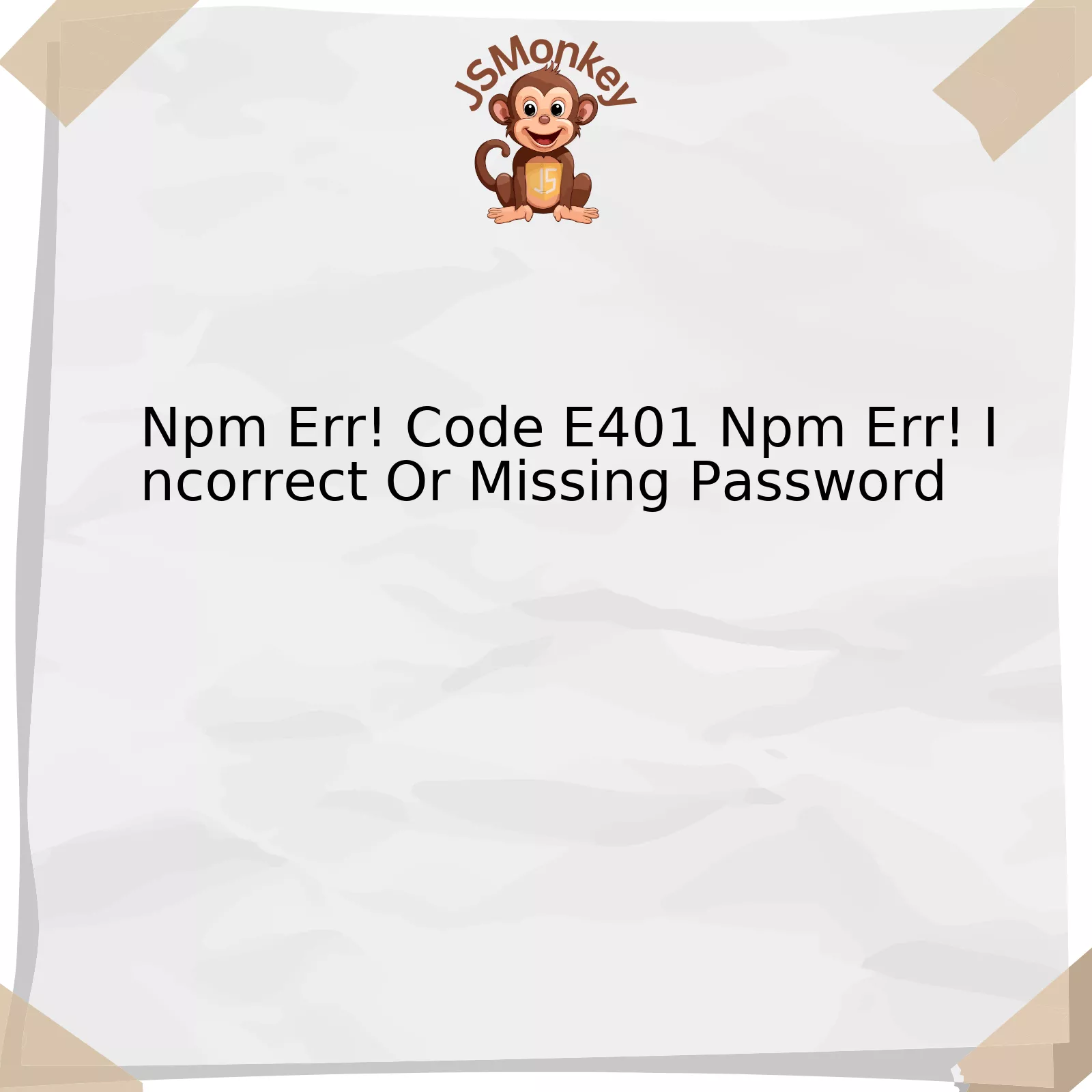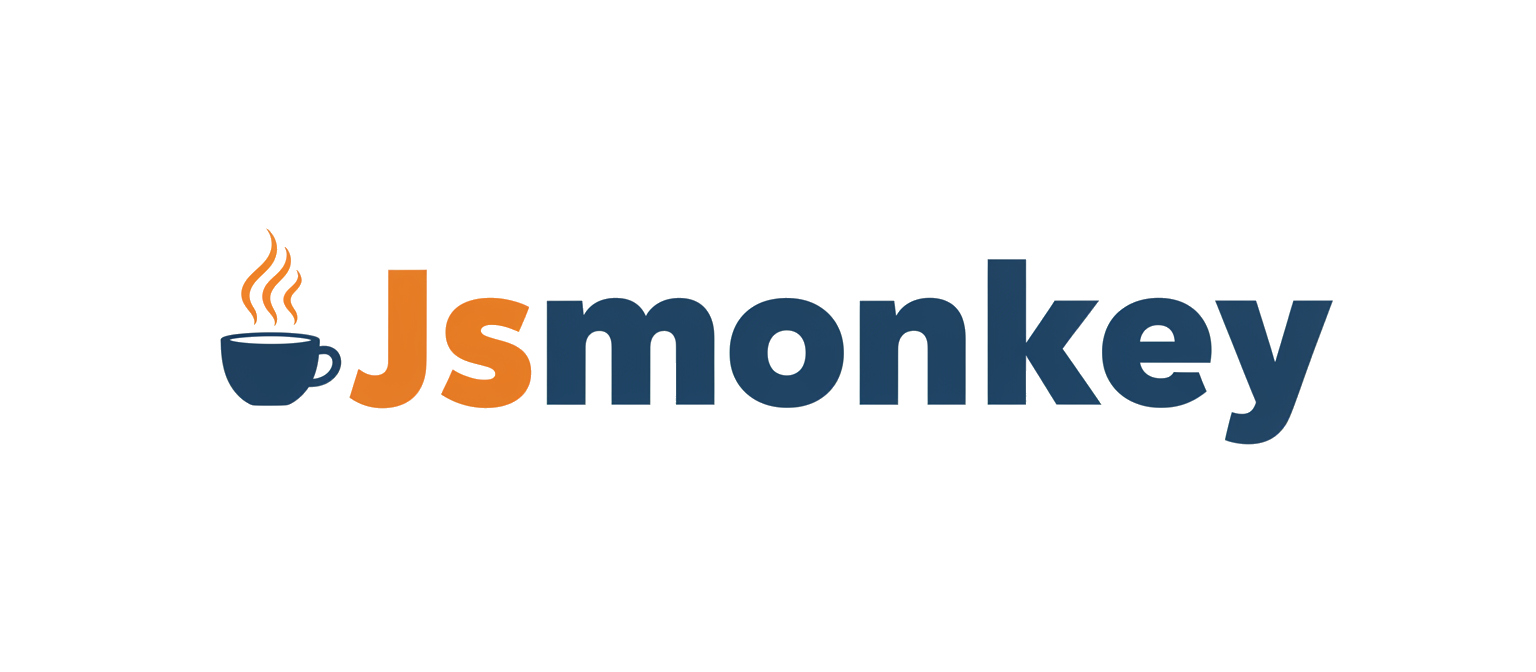
Npm Err! Code E401 Npm Err! Incorrect Or Missing Password

The “Npm Err! Code E401” is a pervasive problem that developers typically encounter when their software tries to interface with the npm registry and the supplied authentication layers. It christens a specific error, signaling an authentication problem primarily due to an incorrect or missing password.
Let’s demystify this, considering its elements and potential solutions via objectifying them visually:
html
| Error Component | Description |
|---|---|
| Npm Err! Code | Depicts that an error has occurred while implementing Npm (Node Package Manager). |
| E401 | The HTTP status code signifying an ‘unauthorized’ request which requires user authentication. |
| Incorrect Or Missing Password | The credential provided isn’t accurate or non-existent, thus barring access. |
The above tabular structure deepdives into three main components of this error: ‘Npm Err! Code’, ‘E401’, and ‘Incorrect Or Missing Password’. These encapsulate essential aspects of the issue at hand – Npm operation, HTTP protocol, and authentication.
– The ‘Npm Err! Code’ intimates that an error has transpired while operating the versatile Node Package Manager (npm). Npm allows JavaScript developers to share packaged modules of code [[1]](https://npmjs.com/about).
– Next, ‘E401’ is an HTTP status code designating ‘Unauthorized’ requests. Effectively, it means the npm registry did not recognize the authorization credentials in the request given, necessitating user authentication for further access.
– Finally, ‘Incorrect Or Missing Password’ underscores that the given password or authentication credential associated with the npm registry is either incorrect or missing in it’s entirety. This invariably hampers the smooth flow of data exchange between nodes and the npm registry.
Whilst Gary Bernhardt, a notable figure in the field of software development once said, ‘Programming is not about typing, it’s about thinking.’, there are ways to solve this technical hindrance. Correcting the password for the npm registry or adding one if it’s missing, spring as viable solutions to alleviate this issue. Furthermore, being careful about spelling, typos, and ensuring the correct protocol structure could also potentially save from such pitfalls.
In fact, if the error remains persistent despite implementing correctly structured credentials, you may want to consider cleansing your npm cache or verifying your proxy settings – sometimes, these can contribute to erroneous states due to outdated information or restricted access.
Understanding NPM ERR! Code E401: An Overview

NPM ERR! Code E401 is an error notification that users witness when they are looking to effectively manage their project packages by utilizing Node Package Manager (NPM). This error occurs when the NPM client is either unauthorized or unauthenticated to connect with the requested package scope, mostly due to incorrect or missing password details.
There can be two plausible reasons for this specific error:
1. You are not properly authenticated: `
npm login
` demands authentication. If you have entered incorrect credentials, it would result in an E401 error.
2. Not having the right permission or being unauthorized: In several registries, there is an access control mechanism in place, and corresponding permissions are required to publish or manage packages.
Here’s a solution approach to solve the issue:
1. Reauthenticate purposes: Log out from npm using `
npm logout
` and try logging in again using `
npm login
`. Be careful while entering your credentials.
2. Registry checking: Make sure that you’re operating with the correct registry where you’ve the necessary permissions.
3. Review the .npmrc file: It is possible that `npm` is trying to retrieve packages from different scopes which you might be unaware of. The `.npmrc` file will help identify these scopes if any exists.
It is very well expressed by Phil Karlton: “There are only two hard things in computer science: cache invalidation and naming things.” And caching issues could also be the prime suspects for npm ERR! code E401.
To understand such errors in-depth, analyzing the debugging log file (`npm-debug.log`) can be beneficial. This error usually indicates a problem with your network connection, especially with respect to connectivity to the NPM repository. Hence, thorough introspection and mindful understanding of logs can lead to faster resolution of such problems.
Lastly, check for any available software updates regularly. Doing this not only enhances your system performance but also fixes potential issues that might have introduced such errors.
Remember to ensure your project security level and handle sensitive data, passwords in particular with responsibility.
Exploring the Causes of NPM ERR! Incorrect or Missing Password

When dealing with
NPM ERR! Code E401
, particularly the error message “Incorrect or Missing Password,” it’s critical to understand underlying potential causes and effective solutions. This error frequently emerges from issues tied to authentication or login details with npm registry.
Diving into the depths of “NPM ERR! Incorrect or Missing Password”, the key triggers typically include:
– **Erroneous npm Registry Links**: Wittingly or unwittingly, we sometimes configure wrong npm registry links in our projects. The error might arise due to a mismatch between the package registry configured in your project and your actual registry where you hold credentials.
– **Incorrect Password Entry**: Pure human error is another significant factor. Typing an incorrect password when prompted can trigger this error message.
– **Absence of Login Session**: If you are attempting to download a private package and you haven’t logged into your npm account, npm won’t be able to authenticate, giving rise to an “Incorrect or Missing Password” error.
– **Cache Issues**: Sometimes, the npm cache mechanism might harbor erroneous data or fail to refresh the login session properly. This expired or false cached data could potentially interfere with registry authentication.
Addressing the problem effectively requires a sound understanding of each possible cause. Here’s how we can tackle these challenges:
– **Rectify npm Registry Links**: Inspect your package.json file and .npmrc settings, ensure they point to the right URLs. Keeping our registry links accurate is a simple step that often resolves the issue at hand.
– **Re-enter Your Password**: Human error is ever-present and easy to overlook. Try typing your password again, watching for typos or mismatched character cases.
– **Login to your npm account**: Before fetching a package, make sure to log into your npm account using the command
npm login
. Once prompted, fill in your username, password, and email for npm to authenticate.
– **Clear npm Cache**: Use the command
npm cache clean --force
to help reset your cache. This action clears out any cached data ensuring a fresh slate for npm operations.
Each solution directly relates to a potential cause, bringing us closer to effective error resolution. One of these techniques will likely prove successful in tackling the “NPM ERR! Code E401” message that can often hinder our development momentum.
Marc Andreessen, a co-founder of Netscape and an influential figure in the technological sphere, once said: “Innovation is the central issue in economic prosperity.” By understanding how to tackle errors head-on with practical solutions, we not only innovate but also clear the path towards more fruitful development experiences.[1].
Efficient Solutions for Resolving NPM Authentication Errors

NPM Authorization Errors, most notably the “npm ERR! Code E401 npm ERR! Incorrect or missing password” can be a real hurdle for many JavaScript developers. Such hindrances interrupt the workflow and necessitate immediate solutions to get the code deployment process back on track.
Analyzing the error message you’ve described exposes that it’s an authorization error, specifically an HTTP 401 Error associated with NPM login credentials. Herein, we’ll delve into some insightful ways to efficiently handle this impasse and subsequently automate the processes to nip such disturbances in the bud.
Let’s first understand what this particular error code implies:
npm ERR! Code E401 npm ERR! Incorrect or missing password
The HTTP 401 Error denotes unauthorized access, implying that the request you made requires user identification. In the context of NPM (Node Package Manager), it signifies issues with your NPM account credentials—essentially, either the username, password, or email is incorrect.
Here are some efficient solutions based on my experience:
1. **Double-check your credentials:** Overlooking simple details happens to even the best developers. It is thus advisable to recheck your typed-in credentials. Minor keys placed mistakenly like Caps Lock could be the villain behind the scene.
2. **Authentication info overload in .npmrc file:** You might be experiencing this problem due to duplicated or surplus auth information in the npm config- .npmrc file. The fixed solution is to check and clean the registry entries corresponding to your package manager.
Here’s how you typically clean-up .npmrc entries:
// Remove auth token $ npm logout // Add auth token $ npm login
3. **A disconnected network or VPN issue**: At times an unstable internet connection may also lead to npm ERR! Code E401. So, checking your network connectivity is worthwhile. Equally important is to ensure that your VPN’s location setting doesn’t conflict with the package registry region, causing the password validation process to fail.
4. **Create a new token:** This is another effective method whereby you create a new authorization token via npm’s website. Do remember to update this new token in all places where the old token was in use.
5. **Use of deprecated npm versions:** The version of npm you’re currently using could also be the cause of npm ERR! Code E401. Old versions might have bugs which newer versions have resolved. Hence, regularly updating npm as well as other related tools is a prudent strategy.
In the words of Douglas Crockford, a renowned JavaScript developer: “Programming is the most complicated human activity. If something can go wrong, it will.” While one ought to counter issues like npm ERR! Code E401 promptly, anticipating such speed breakers and having a plan even before they surface is what differentiates an experienced developer. Automated Server Monitoring tools or incorporating CI/CD pipelines in your workflow are pathways to reduce manual error troubleshooting and bring in more efficiency.
For more granularity on npm ERR! Code E401, refer to these hyprelinked discussions on [StackOverflow](https://stackoverflow.com/questions/51158150/npm-err-code-e401-npm-err-more-info-https-registry-npmjs-com-some-private-p) and the official [npm documentation](https://docs.npmjs.com/cli/v7/using-npm/registry).
Prevention Steps to Avoid Future Occurrences of Code E401 Error

The Npm Err! Code E401 error often refers to an incorrect or missing password. This issue can arise for a few reasons: you might be using an incorrect password while logging into your npm profile, not setting up an _.npmrc_ file correctly, or perhaps there’s an unexpected token somewhere in your session data. To help prevent this type of problem from occurring and avoid future occurrences of Code E401 Npm Err! errors, try implementing the following strategies:
1. **Use Strong, Accurate Passwords**: Your npm registry login information should be private and secure. Always double-check your details before entering them. Moreover, it is recommended to regularly update your credentials.
npm login
2. **Correctly SetUp _.npmrc_ File**: Npm uses an _.npmrc_ file to store configurations. Typically located in the user’s home directory, this file contains important information like authentication details. If this crucial file is improperly set up, it may result in an E401 error. Ensure it is appropriately set up, by executing
npm get registry
. It will show you the registry currently being used by your setup.
3. **Clear Cache**: Occasionally, the npm cache could hold erroneous or outdated session data. By performing a cache clean-up, these potentially problematic pieces of stored data get removed. Use
npm cache clean --force
but be careful as it deletes all data from your npm cache.
4. **Update NPM Version**: Having an outdated npm version might also cause this error. Make sure to keep your npm updated to its latest version.
npm install g npm@latest
| Action | Code command |
|---|---|
| Password correction or updation | npm login |
| Check _.npmrc_ file setup | npm get registry |
| Clear Cache | npm cache clean –force |
| NPM Version Update | npm install -g npm@latest |
Applying these strategies can be immensely beneficial in minimizing the risk of error E401 occurrence. To quote Alan Turing, an iconic figure in computational science, “We can only see a short distance ahead, but we can see plenty there that needs to be done.” – It is always important to control what we have within our reach and applying these prevention measures can positively affect how you interact with npm, improving your productivity and software development performance.
Visit NPM Documentation on Cache for more details regarding this topic.
If one encounters the error “Npm Err! Code E401 Npm Err! Incorrect Or Missing Password”, it fundamentally designates an authentication issue with npm (Node Package Manager). This occurs during the process of installing, updating or publishing npm packages. It’s vital to consider that such a problem commonly arises when the credentials used do not match with npm’s stored records.
| Error | Cause | Solution |
|---|---|---|
| Npm Err! Code E401 | Incorrect / Missing password | Re-enter correct credentials |
A possible effective approach can be aborting and initiating a novel session by first logging out via
npm logout
, thereafter logging back in using
npm login
. This ensures fresh credentials are used for authenticating.
Besides, checking the npm registry website to confirm if the user account is valid or active can help to validate the correctness of logged in user credentials. One should also ensure they have the proper rights to access certain packages, especially private ones.
An additional practical solution could be rectifying the .npmrc files where tokens or passwords might be stored. Apply necessary fixes if these are misconfigured or outdated.
As Bill Gates once said, “I choose a lazy person to do a hard job. Because a lazy person will find an easy way to do it.” The applied analogy here means instead of troubleshooting continuously with failed solutions, finding the easier and right solution like verifying our login credentials or resolving possible issues with .npmrc files can save time and effort.
Being aware of these causes and remedies addressed to “Npm Err! Code E401 Npm Err! Incorrect Or Missing Password” error, we equip ourselves in proficiently handling issues tied to npm, granting us more productive time to focus on development tasks. Consequently, it leads towards the effective and efficient use of npm as a crucial tool in JavaScript-based development.


